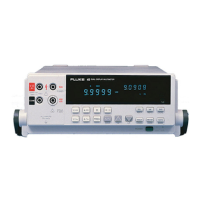45
Service Manual
7-10
7. Observing the polarity markings on the battery pack, connect the red wire to the
positive (+) terminal. Then connect the black (or brown) wire to the negative (-)
terminal. Reversal of these connections causes fuse F1 to open.
7-16. Low Battery Indicator Detector and Low Battery Disconnect Test
The following test is necessary only after repairs have been made to either the Low
Battery Indicator Detector or the Low Battery Disconnect circuit.
1. Turn the meter OFF.
2. Unplug the two battery pack connectors from the battery pack terminals. Observing
the correct polarity, connect the variable power supply to the two battery pack
connectors.
3. Connect the voltmeter across the variable power supply.
4. Set the variable power supply to approximately 9 volts.
5. Now turn the meter ON, and check for correct operation of the Low Battery
Indicator symbol.
• While watching the display, slowly lower the variable voltage power supply
output. Check that the low battery indicator symbol comes on at 7.7 ±0.25 V dc.
• Now, slowly increase the variable voltage supply output. Check that the low
battery indicator symbol goes out at about 8 V dc.
6. Check the Low Battery Disconnect point.
• With the meter still operating on the variable supply, slowly lower the voltage,
and check that the meter goes OFF at about 7.0 V dc.
• After the meter goes OFF, slowly increase the voltage, and check that the meter
does not come ON before approximately 8.0 V dc.
Note
The meter may not come on, above 8 volts until the power is cycled.
7. There are no adjustments to set the Low Battery Indicator point or the Low Battery
Disconnect point.
7-17. Cycle/Float Charge Rate Switch Test
Use the following procedure to verify operation of the meter's Cycle/Float Charge Rate
Switch. Note that this test is required only after repairs have been performed on the
Cycle/Float Rate Switch Test circuits.
1. Turn the meter OFF.
2. For this procedure, use a battery simulator as a substitute for the regular battery
pack. Connect this simulator (shown in Figure 7-5) as follows:
• Connect a 33Ω, 5W load resistor in parallel across the output of a variable
voltage power supply.
• Disconnect the battery charger wires from the battery.
• Connect the simulator to the battery charger wires. Install a 0.1Ω shunt resistor
in series with the red wire.
• Connect a voltmeter across the shunt resistor to measure the voltage drop across
and the charging current through the resistor.

